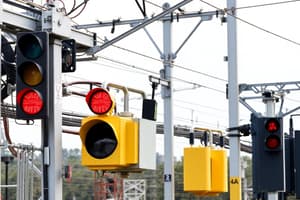Podcast
Questions and Answers
What is the maximum allowable voltage drop in the cable from the integrated power supply to the Electronic Interlocking rack?
What is the maximum allowable voltage drop in the cable from the integrated power supply to the Electronic Interlocking rack?
1.0 volt
In the context of Electronic Interlocking, how should the DC-DC converters be configured?
In the context of Electronic Interlocking, how should the DC-DC converters be configured?
They should be in N+1 configuration and segregated for 'A' & 'B' systems.
What is the maximum line drop permitted for the DC-DC converter installed near the EI rack?
What is the maximum line drop permitted for the DC-DC converter installed near the EI rack?
0.5 volt
How should the cables for the 110V DC power supply be managed in relation to other wiring in the Electronic Interlocking room?
How should the cables for the 110V DC power supply be managed in relation to other wiring in the Electronic Interlocking room?
Signup and view all the answers
What type of configuration should be used for the DC-DC converter that provides power for VDU PC/Panel processor modules in the SM room?
What type of configuration should be used for the DC-DC converter that provides power for VDU PC/Panel processor modules in the SM room?
Signup and view all the answers
What is the significance of isolating the 24V or 110V DC supply for the fan from the Electronic Interlocking supply?
What is the significance of isolating the 24V or 110V DC supply for the fan from the Electronic Interlocking supply?
Signup and view all the answers
What type of inverter is specified for providing the 230V AC supply for the VDU monitor?
What type of inverter is specified for providing the 230V AC supply for the VDU monitor?
Signup and view all the answers
What should be done with the inverter's 230V AC input cable?
What should be done with the inverter's 230V AC input cable?
Signup and view all the answers
What is the preferred housing for the panel processor in the EI system?
What is the preferred housing for the panel processor in the EI system?
Signup and view all the answers
How should the connectivity between the EI and other components like VDU and CPU be planned?
How should the connectivity between the EI and other components like VDU and CPU be planned?
Signup and view all the answers
What temperature range must the optical modem operate within?
What temperature range must the optical modem operate within?
Signup and view all the answers
What is the purpose of using a ring system for communication lines in a distributed system?
What is the purpose of using a ring system for communication lines in a distributed system?
Signup and view all the answers
What should be ensured to maintain earth resistance at the equipment?
What should be ensured to maintain earth resistance at the equipment?
Signup and view all the answers
What type of conductor should be used for buried earthing to prevent theft?
What type of conductor should be used for buried earthing to prevent theft?
Signup and view all the answers
Why is proper earthing important for Surge Protection Devices (SPDs) in EI systems?
Why is proper earthing important for Surge Protection Devices (SPDs) in EI systems?
Signup and view all the answers
When should the data logger be commissioned in relation to the EI system?
When should the data logger be commissioned in relation to the EI system?
Signup and view all the answers
What is the minimum officer level required to verify and certify the synchronization of EI clock and data logger clock?
What is the minimum officer level required to verify and certify the synchronization of EI clock and data logger clock?
Signup and view all the answers
What gap is recommended between different cable troughs for routing input, output, data, and power supply cables?
What gap is recommended between different cable troughs for routing input, output, data, and power supply cables?
Signup and view all the answers
Why should the input and output cables of EI be twisted?
Why should the input and output cables of EI be twisted?
Signup and view all the answers
What is the minimum officer level required to scrutinize and verify input and output details before commissioning?
What is the minimum officer level required to scrutinize and verify input and output details before commissioning?
Signup and view all the answers
What type of devices should be installed according to the electronic interlocking installation document?
What type of devices should be installed according to the electronic interlocking installation document?
Signup and view all the answers
What type of system should be planned for commissioning to avoid failures due to resets?
What type of system should be planned for commissioning to avoid failures due to resets?
Signup and view all the answers
What should be done with voltage monitoring cables to ensure proper installation?
What should be done with voltage monitoring cables to ensure proper installation?
Signup and view all the answers
What is the purpose of the Factory Acceptance Test (FAT) during the installation process?
What is the purpose of the Factory Acceptance Test (FAT) during the installation process?
Signup and view all the answers
Study Notes
Technical Advisory Note - Electronic Interlocking Installation
- This document supersedes a previous version, dated 10.08.2016.
- It provides guidelines for installing Electronic Interlocking (EI) systems.
- The guidelines are based on analysis of Technical System Application Approval (TSAA) documents from RDSO over five years.
- The guidelines aim to expedite TSAA clearance from RDSO and boost EI installation reliability.
Power Supply Arrangement
-
Duplicate cables: 110V DC supply from the IPS room to the El rack should use duplicated cables of appropriate gauge to prevent voltage drops exceeding 1 volt.
- This redundancy combats potential issues like rat bites or damage.
-
DC-DC converters: DC-DC converters for the EI system should be segregated (A & B) with separate cabling and termination.
- They should be in an N+1 configuration.
- Reliable converters as advised by OEMs are recommended. The required sketches are in Annexure A1 & A2.
- This redundancy helps maintain system availability if one converter fails.
- The converters should be placed near the rack to minimize voltage drop (no more than 0.5 volts).
-
External power supply for fans: 24V or 110V DC fan power should be sourced from a separate, external isolated power supply with fuses.
- This is to avoid issues caused by inductive loads on the main EI equipment's power supply and protects against fan short circuits.
-
230V AC power supply: Use a separate inverter (230V AC output, 24V DC, pure sine wave with SPD) for the VDU monitor to avoid lightning impacts.
- Unplug the 230V AC input cable from the inverter.
Communication Arrangement
-
Panel processor location: The panel processor should be housed within the control cum indication panel (CCIP).
- Use optical fiber cable (OFC) for connections to avoid damage from cutting and lightning.
- This space-saving configuration enhances reliability.
-
High reliability communication: Using OFC for connections between various components (El to VDU, CPU-to-CPU, El to Object Controller, El to PPM) enhances survivability to surge and lightning, ensuring stability and availability.
- This strategy also uses a ring system to prevent network failures.
- Network Management System (NMS) for the OFC and other networks are recommended.
Earthing Arrangement
- Class A Protection: Ensure class A lightning protection measures on the building's top.
- Copper Tape: Use bonding ring conductors on insulated stand-offs to cover relay rooms; ensure short paths to earth.
- Earth Resistance: Ensure earth resistance is less than 1 Ohm for equipment. This is to minimize any potential damage during surges.
-
Proper Earthing: Ensure the buried earth conductor, preferably copper, is also electrically connected through all relay racks and cabinet enclosures, including front and back doors.
- Using copper braids is recommended in this case.
- SPD Provisions: Ensure surge protection devices (SPDs) for electronic interlocking devices and ensure proper earth connections for all cabinets.
Data Logger Installation
- Commissioning: Commission the data logger before the El system. Wire all external relay contacts to the data logger.
- Synchronization: Verify synchronization between the El clock and the data logger clock through CMU.
- Analog Monitor: Wire the DC-DC converter output data to the data logger for health monitoring. This enhances preventive and predictive maintenance.
Wiring Practices
- Cable Routing: Route input, output, data, and power cables in separate cable troughs to maintain electrical separation and avoid interference.
- Twisted Pairs: Twist input and output cables to minimize electromagnetic interference.
- Fuse Terminals: Appropriately label fuse terminals with ratings and numbers.
- Surge Protection: Install surge protection devices as per the outlined documents.
- Wire Connections: Ensure proper crimping and secure connections at wire ends. Maintain a 6-8 inch separation for cables in cable trays to prevent mutual induction.
- 110V/ External DC separation: Separate 110V AC external power lines from 12V/24V/50V DC internal power lines to prevent surges from damaging equipment. This also applies to voltage monitoring lines, including those of the data logger.
Other Requirements and Processes
-
JAG Officer Involvement JAG officers must verify input and output details and logic during commissioning, and their involvement should then be recorded with certificates submitted to RDSO.
-
Factory and Site Acceptance Tests: Factory and site acceptance tests, including sample verifications, should be done by railway officials and JAG officials for improved reliability.
-
Embedded VDU guidelines: Adhere to guidelines for embedded VDU specification from a previous Technical Advisory Note (Document STS/E/TAN/3007).
-
OEM Responsibilities: OEMs must guarantee the quality and integrity of the Electronic interlocking installation, cover any discovered deficiencies post-installation, and provide the necessary certification before commissioning.
-
Commissioning Checklist: Execute the pre-commissioning check-list, involving Assistant officers at the site level and the executing OEM.
Studying That Suits You
Use AI to generate personalized quizzes and flashcards to suit your learning preferences.
Related Documents
Description
Test your knowledge on Electronic Interlocking systems, focusing on power supply configurations, voltage drops, and wiring management. This quiz covers essential aspects such as DC-DC converters and the setup for electronic components in the Electronic Interlocking room.




